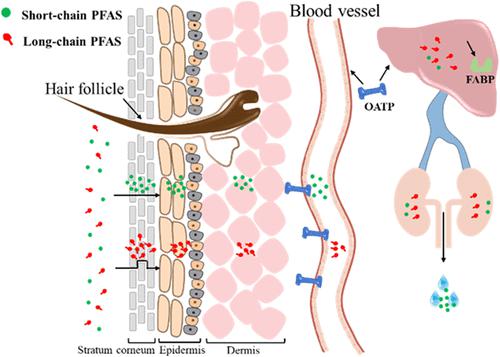当前位置:
X-MOL 学术
›
Environ. Sci. Technol.
›
论文详情
Our official English website, www.x-mol.net, welcomes your
feedback! (Note: you will need to create a separate account there.)
Insights into the Dermal Absorption, Deposition, and Elimination of Poly- and Perfluoroalkyl Substances in Rats: The Importance of Skin Exposure
Environmental Science & Technology ( IF 10.8 ) Pub Date : 2022-11-23 , DOI: 10.1021/acs.est.2c03181 Qiaoying Chen 1 , Shujun Yi 1 , Qingqing Ye 1 , Yumin Zhu 1 , Wenjue Zhong 1 , Lingyan Zhu 1
Environmental Science & Technology ( IF 10.8 ) Pub Date : 2022-11-23 , DOI: 10.1021/acs.est.2c03181 Qiaoying Chen 1 , Shujun Yi 1 , Qingqing Ye 1 , Yumin Zhu 1 , Wenjue Zhong 1 , Lingyan Zhu 1
Affiliation

|
Humans are frequently exposed to poly- and perfluoroalkyl substances (PFASs) via direct skin contact with personal care and consumer products containing them. Here, we used a rat model to estimate the dermal penetration efficiency of 15 representative PFASs. After 144 h post-dosing, 4.1–18.0 and 5.3–15.1% of the applied PFASs in the low (L) and high (H) groups, respectively, were absorbed into the rats. PFAS absorption and permeation were parabolically associated with the perfluorinated carbon chain length (CF), peaking for perfluoroheptanoic acid (PFHpA). The lipid-rich stratum corneum of the skin barrier substantially suppressed the penetration of less hydrophobic short-chain PFASs, whereas the water-rich viable epidermis and dermis served as obstacles to hydrophobic long-chain PFAS permeation. However, the renal clearance (CLrenal) of the target PFAS decreased with increasing CF, suggesting that urinary excretion is crucial to eliminate less hydrophobic short-chain PFASs. Notably, the peak times of PFASs in the systemic circulation of rats (8–72 h) were remarkably longer than those after oral administration (1–24 h). These results suggest that dermal penetration can be long-lasting and contribute considerably to the body burden of PFASs, especially for those with moderate hydrophobicity due to their favorable skin permeation and unfavorable urinary excretion.
中文翻译:

对大鼠皮肤吸收、沉积和消除聚和全氟烷基物质的洞察:皮肤暴露的重要性
人类经常通过皮肤直接接触含有这些物质的个人护理和消费品而接触到聚和全氟烷基物质 (PFAS)。在这里,我们使用大鼠模型来估计 15 种具有代表性的 PFAS 的皮肤渗透效率。给药后 144 小时后,低 (L) 组和高 (H) 组应用的 PFAS 分别有 4.1-18.0% 和 5.3-15.1% 被大鼠吸收。PFAS 吸收和渗透与全氟化碳链长度呈抛物线相关 ( C F), 全氟庚酸 (PFHpA) 的峰值。皮肤屏障富含脂质的角质层大大抑制了疏水性较差的短链 PFAS 的渗透,而富含水分的活表皮和真皮则阻碍了疏水性长链 PFAS 的渗透。然而,目标 PFAS 的肾脏清除率(CL肾脏)随着C F的增加而降低,表明尿液排泄对于消除疏水性较低的短链 PFAS 至关重要。值得注意的是,PFASs 在大鼠体循环中的峰值时间(8-72 小时)明显长于口服给药后的峰值时间(1-24 小时)。这些结果表明,皮肤渗透可能会持续很长时间,并且会显着增加 PFAS 的身体负担,特别是对于那些由于其有利的皮肤渗透和不利的尿液排泄而具有中等疏水性的人。
更新日期:2022-11-23
中文翻译:

对大鼠皮肤吸收、沉积和消除聚和全氟烷基物质的洞察:皮肤暴露的重要性
人类经常通过皮肤直接接触含有这些物质的个人护理和消费品而接触到聚和全氟烷基物质 (PFAS)。在这里,我们使用大鼠模型来估计 15 种具有代表性的 PFAS 的皮肤渗透效率。给药后 144 小时后,低 (L) 组和高 (H) 组应用的 PFAS 分别有 4.1-18.0% 和 5.3-15.1% 被大鼠吸收。PFAS 吸收和渗透与全氟化碳链长度呈抛物线相关 ( C F), 全氟庚酸 (PFHpA) 的峰值。皮肤屏障富含脂质的角质层大大抑制了疏水性较差的短链 PFAS 的渗透,而富含水分的活表皮和真皮则阻碍了疏水性长链 PFAS 的渗透。然而,目标 PFAS 的肾脏清除率(CL肾脏)随着C F的增加而降低,表明尿液排泄对于消除疏水性较低的短链 PFAS 至关重要。值得注意的是,PFASs 在大鼠体循环中的峰值时间(8-72 小时)明显长于口服给药后的峰值时间(1-24 小时)。这些结果表明,皮肤渗透可能会持续很长时间,并且会显着增加 PFAS 的身体负担,特别是对于那些由于其有利的皮肤渗透和不利的尿液排泄而具有中等疏水性的人。











































 京公网安备 11010802027423号
京公网安备 11010802027423号